![]()
![]()
![]()
Use LEFT and RIGHT arrow keys to navigate between flashcards;
Use UP and DOWN arrow keys to flip the card;
H to show hint;
A reads text to speech;
54 Cards in this Set
- Front
- Back
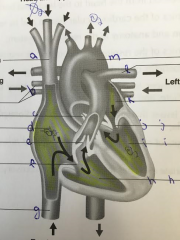
what is a?
|
superior vena cava
|
|
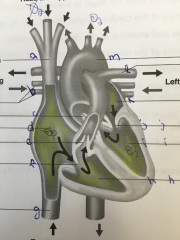
what is b?
|
pulmonary veins
|
|
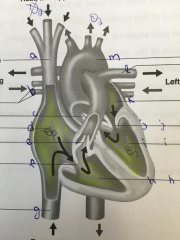
what is c?
|
aortic valve
|
|
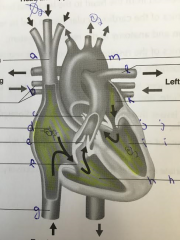
What is d?
|
right atrium
|
|
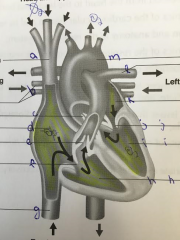
what is e?
|
pulmonary valve
|
|
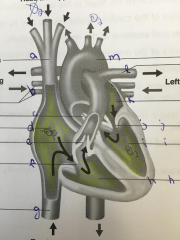
what is f?
|
tricuspid valve
|
|
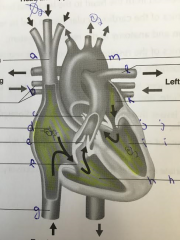
what is g?
|
inferior vena cava
|
|
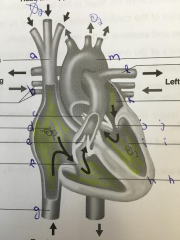
what is h?
|
right ventricle
|
|
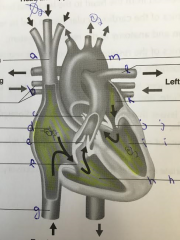
what is i?
|
left ventricle
|
|

what is j?
|
mitral valve
|
|

what is k?
|
left atrium
|
|

what is L?
|
pulmonary artery
|
|
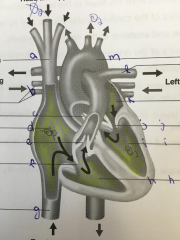
what is m?
|
aorta
|
|
|
cardiovascular+respiratory
|
deliver O2, remove CO2, remove waste, deliver nutrients
|
|
|
Cardiovascular system
|
-heart+network of arteries -responsible for circulation of blood, transport of nutrients, O2, CO2, metabolic waste products, and hormones+helps maintain core temp -left=systemic circulation, right=pulmonary circulation |
|
|
Circulation order
|
aorta-arteries-arteriols-capillaries-veins
|
|
|
Blood Pressure
|
-average resting BP 120/80 (if over 140=nope) -top#=systolic, when the heart contracts -bottom#=diastolic, when the heart relaxes(fills) |
|
|
Heart Rate
|
approx. 72 bpm @ rest (more than 100=nope)
|
|
|
Stroke Volume
|
SV= amount of blood the left ventricle pushes out in one beat
|
|
|
Cardiac Output
|
Q= SV x HR -amount of blood the heart ejects in 1 min |
|
|
Respiratory system
|
-left and right lungs and air pathways |
|
|
Ventillation
|
process of moving air in+out of the lungs
|
|
|
Diffusion
|
gas exchange in the lungs (osmosis)
|
|
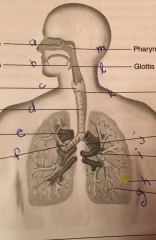
What is a?
|
conchae
|
|
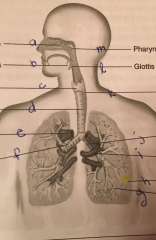
What is b?
|
epiglottis
|
|

What is c?
|
larynx, vocal cords
|
|
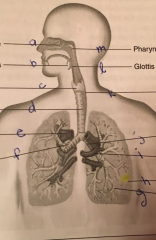
What is d?
|
trachea
|
|
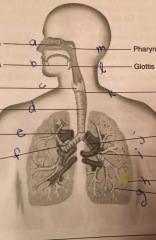
What is E?
|
pulmonary artery
|
|

What is f?
|
right main bronchus
|
|
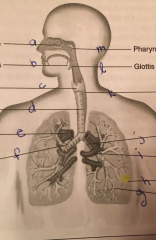
What is g? |
bronchiole
|
|
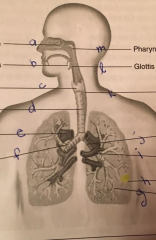
What is H?
|
alveoli
|
|
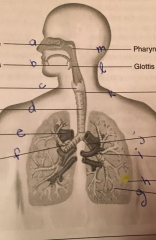
What is i?
|
pulmonary veins
|
|
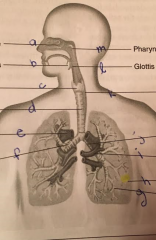
What is j?
|
left main bronchus
|
|
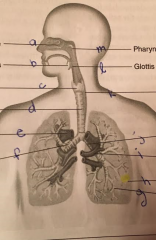
What is k?
|
esophagus
|
|
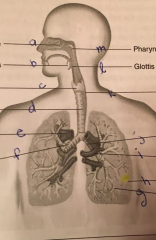
What is L?
|
glottis
|
|

What is m?
|
pharynx
|
|
|
VO2max
|
VO2= O2 delivery x O2 extraction -max volume of O2 your body can use |
|
|
For cardiorespiratory recovery, assist by:
|
-lowering intensity+impact of the exercise -reducing the ROM of mvmts -tell client to consciously begin in active revovery |
|
|
Benefits of cardiorespiratory training
|
-reduce risk of heart disease -lower resting HR -normalizing resting BP -increase stroke volume |
|
|
Exercise prescription
|
FITT
|
|
|
Exercise frequency
|
#times/week -300mins moderate or 150 vigorous -optimal effects= 4-5 training sessions/week |
|
|
Exercise Intensity
|
rate of work -speed/load of work (% of HRmax) -3 methods of monitoring= O2 uptake, HR monitoring, perceived exertion |
|
|
HR
|
HR= 220-age -increases linearly w O2 uptake/ exercise intensity -heart capacity decreases w age |
|
|
% of maximum HR (target HR)
|
Target HR= (220-age) x % -targer HR training zone = 55%-90% >beginners= 55-64% >intermediates= 65-74% >advanced= 75-90% |
|
|
Heart Rate Reserve (HRR)
|
Targer HR= [(HRmax-restingHR)x%]+restingHR (HRR method) |
|
|
Rate of Perceived exertion (RPE)
|
-clients rate their exertion using a numeric system |
|
|
Borg Scale
|
6-no exertion at all 7- extremely light 8-"" 9-very light 10 11-light 12 13-somewhat hard 14 15-hard (heavy) 16 17-very hard 18 19-extremely hard 20-maximal exertion |
|
|
Exercise type
|
type of activity + mode
|
|
|
Cardiorespiratory training guidelines: beginners, program focus
|
-improve health profile -increase nrg -daily activities made easier -weight reduction |
|
|
C.r. training guidelines: beginners, FITT
|
F: 1-3 time/week I: 55-64% HRmax, RPE 9-12 T: 15-30mins T: walking, swimming, stationary cycling... |
|
|
Cardioresp. training guidelines: intermediate, program focus
|
-weight reduction -program variety |
|
|
Cardioresp training guidelines: intermediate, FITT
|
F: 3-5 time/week I: 65-74% HRmax, RPE 12-15 T: 20-45mins T: stairs, treadmill, crosstraining |
|
|
Cardioresp. training guidelines: advanced, program focus
|
-increase VO2 max -weight maintenace -sport training -competition |
|
|
Cardioresp training guidelines: advanced, FITT
|
F: 4-6 times/week I: 75-90% HRmax, RPE 13-16 T: 40-60mins T: complex mvmts, sports, intervals, xtraining |

